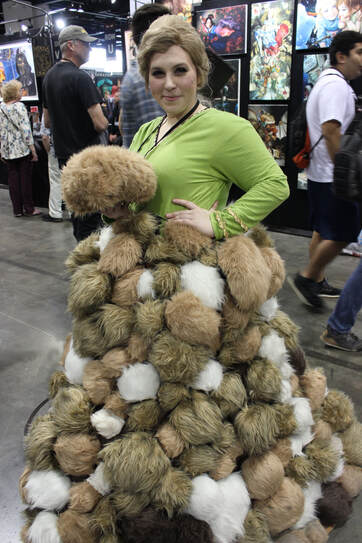Written by Joel T. Lewis  Relocating is difficult for everyone, but especially for a nerd. Relocating and downsizing is especially difficult as it forces us to reanalyze the stuff-i-fication of our fandoms and reprioritize collections that might have spiraled out of control. My partner and I moved 2 weeks prior to this year’s Denver Pop Culture Con from a roomy if haphazardly laid out 2-bedroom apartment with massive closet space into a much nicer one bedroom apartment. The existential (and literal) weight of my collections was crippling as I was faced with the task of moving everything I had collected to our new home and then finding space for it to live in once it was moved. No collection weighed more heavily on my mind than my comic books. One longbox and 4 short boxes is not the most extensive collection, but with time and space running short, the collection had to be culled, and more than a month later and a short box and a half lighter the process continues. As I fluctuated from aggressive minimalism and materialistic mourning, I entered Denver Pop Culture Con with a familiar sense of fiscal irresponsibility as I strolled longingly through the stretches of Artist’s Alley and Merchant Mesa. But this year that longing was tempered by a dull ache, the still tender remembrance that there was no place to put the nerd stuff I so desperately wanted. If my comic’s collection had been respectable before, it was the Denver Comic Cons of the past few years that helped it grow robust. The booths of comic sellers from all over the country introduced me to the concept of ‘bricking,’ selling complete runs of comics together in a cellophane brick, effectively kryptonite for an impressionable collector whose wish list was vast and seemingly insurmountable. Buying comics this way I discovered underappreciated gems (Propeller Man 1993 1-8), filled massive gaps in my collection (Marc Spector: Moon Knight 1989 1-50), and went down rabbit holes that I eventually had to dig my way out of (Supreme Power 2003 1-18). But buying by the brick wasn’t the only habit I developed that needed to be overcome, I had to unlearn ‘Buying Spite.’ This is one of the more frustrating habits I picked up, dazzled by the abundance of long boxes and vendors at conventions. It is best represented by my experience last year. I was desperately searching for Daredevil (1964) issue 191, my interest peaked by a response Jeff Lemire gave in a panel just a few weeks earlier. He was asked about the comics that shaped his fascination with the medium and he answered that the famous ‘Roulette’ issue of Daredevil had shown him how serious comic book storytelling could be, and shameless Lemire fanboy that I am, I had to hold in my hand the issue that very well may have spurred my favorite author to create comics himself. Digital spreadsheet in hand, I scoured the booths searching for the issue with Frank Miller’s sunset lit man without fear, crouched like an anguished yellow gargoyle on the cover. Finally triumphant I bought the book in an elated haze paying no mind to the price on the cover. Fast forward to ten minutes later and 3 booths further down the aisle where I found 2 more copies of the same issue, at half the price. As the haze of retail endorphins lifted and was rapidly eclipsed by frustration at my own impatience I doubled down literally, snapping up a second copy of the issue at the lower price. Can I explain this bizarre impulse? I cannot. But it has not been an isolated incident and is an impulse I’ve worked hard to resist. Hot on the heels of moving and the first wave of my collection reduction, I began to develop an inquiry process aimed at the very heart of collecting physical comic books, which was as uncomfortable as it was revealing. On what basis do I choose issues? First and foremost, my selection of physical issues comes from falling in love with the cover art. I’ve stuck with and begun reading series midway through on the basis of cover art alone. This is the strongest pull for me to pick up a book from my local comic shop. Though I do decide to follow specific series on the basis of character, creative team, and storyline, I have bought more issues on the basis of their cover art than any other motivating factor. But what is the advantage of owning an issue on the basis of its cover art alone? This led me to another question: What is the end goal for owning any issue physically instead of digitally? What I began to discover was that my desire to own issues or trades of comics physically was motivated by 3 factors: First, I liked the cover art and wanted to display it, second I enjoyed the story and wanted to lend the issues to my friends, and third I wanted to someday have the issues signed by the artist or author. I realized that in most cases I wasn’t even buying these comics physically for myself or so that I could read them again in the future. I found that these motivations for my physical collection were not sustainable or substantial enough for me to allow them to continue to influence my collecting.  I also became disappointed with the life cycle of my comic books. The initial excitement of picking out the titles and devouring that week’s storyline ultimately undermined by the inevitable banishment of those books to the sad dusty dark purgatory of the short box, shut away from view out of spatial necessity. Especially with Marvel Comics including digital download codes with their physical issues the likelihood of those issues emerging from their cardboard prison continued to decrease. So I was buying issues to put in a box, to await being leant to a friend, or to go into a frame signed or not, never to be opened or read again. I was in this soul-searching state as I walked the exhibition hall of this year’s Denver Pop Culture Con, wincing as my body struggled to come to grips with my collector’s desire and my newfound understanding of what my comics collection had become. This year was a financial triumph for me, resisting the call of UltraSaber’s enticing mystery box deal, and the oh so satisfying feel of Gravity Dice tumbling from my fingers. I spent an unprecedented $30, with the majority of that figure coming late on the final day of the con. This would have been inconceivable to me even a few years ago as I scrambled to complete my Marc Spector: Moon Knight run and pursued the first appearance of the jet and silver avenger in Werewolf By Night number 32. This year I did spent all of that money on comics, but in a tempered and measured headspace, not a fevered desperation as in previous years. I scoped out the booths the first and second days, snapping pictures of issues I was thinking of getting, taking note of the weight they would lift from my wallet, and add to my short boxes. There is something in me that wants to own comic books physically, to support the creators in a way that I get something tangible to show them and have them sign if I get to meet them, to have something to point to when my friends come over or ask for a recommendation. I think there’s a way to do that without breaking the bank, and without cluttering your space to the point where you can’t live comfortably. This is the balance I’m working hard to establish and my experience at this year’s Denver Pop Culture Con was a big step towards reaching that goal. Is there a collection you’ve had to cut back? Do you have anti-clutter strategies you’d like to share? If you want to shoot me a tweet or drop a comment below, I’d love to hear your thoughts on the nerd’s perpetual struggle with stuff. Until Next Time, Geek On!
0 Comments
Leave a Reply. |
Archives
October 2024
|
|
© 2012-2025, Nerds That Geek LLC.
All Rights Reserved. |
uWeb Hosting by FatCow


 RSS Feed
RSS Feed